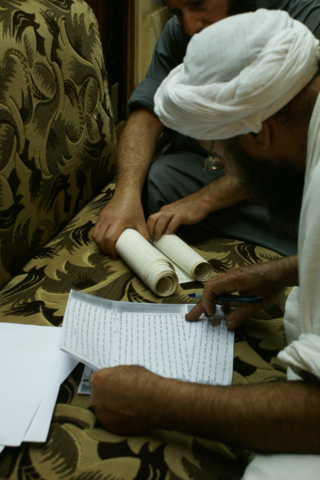

| Part of a series on |
| Mandaeism |
|---|
 |
| Religion portal |

An andiruna (Classical Mandaic : ࡏࡍࡃࡉࡓࡅࡍࡀ, romanized: ʿndiruna, lit. 'chamber' [1] ) is a temporary reed hut used during Mandaean priest initiation ceremonies. [2]


| Part of a series on |
| Mandaeism |
|---|
 |
| Religion portal |

An andiruna (Classical Mandaic : ࡏࡍࡃࡉࡓࡅࡍࡀ, romanized: ʿndiruna, lit. 'chamber' [1] ) is a temporary reed hut used during Mandaean priest initiation ceremonies. [2]
The term andiruna or ʿndiruna (ʿndruna) literally means 'chamber' and can also be used to refer to a wedding chamber or canopy. [3]
Several different priestly texts, including the Scroll of Exalted Kingship (Classical Mandaic : Diwan Malkuta ʿLaita) [4] and The Great Supreme World (Classical Mandaic : Alma Rišaia Rba ), [5] need to kept in the andiruna hut during the initiation ceremony, or else the ceremony would be deemed invalid without the presence of the texts. [2]
During the tarmida initiation ceremony, the initiating priest (rba) and the novice stay in the andiruna hut for one entire week without sleeping. The priest and the novice emerge from the hut after the 7 days are completed, and the hut is taken down. Afterwards, the novice undergoes 60 days of seclusion at home. [6]
During the priest initiation ceremony, another reed hut, the škinta , is constructed to the north of the andiruna. It symbolizes the World of Light and it covered by a white cloth roof. In contrast, the andiruna has a blue cloth roof to symbolize the color of Ruha. Together, the two adjacent huts symbolize complementary masculine and feminine elements. [6]
The andiruna symbolizes the "female" side, and is associated with the earth (Tibil), laypeople, the left side, silver, and the klila (myrtle wreath). [6] Similarly, in a traditional Persian house, the women's quarters are known as andirūn. [2]
The škinta (cognate with the Hebrew word shekhinah; from the Semitic root š-k-n, associated with dwellings) symbolizes the "male" side, and is associated with the World of Light, priests, the right side, gold, and the taga (crown). [6]
| Andiruna | Shkinta |
|---|---|
| female | male |
| Tibil | World of Light |
| laypeople | priests |
| left side (smalࡎࡌࡀࡋ) | right side (yaminࡉࡀࡌࡉࡍ) |
| south (timia) | north (girbia) |
| silver (kaspa) | gold (dahba) |
| klila | taga |
In Mandaeism, kushta or kušṭa can have several meanings. Its original literal meaning is "truth" in the Mandaic language, and is thus typically used to refer to the Mandaean religious concept of truth. The same word is also used to refer to a sacred handclasp that is used during Mandaean rituals such as the masbuta, masiqta, and priestly initiation ceremonies.

The Qulasta, also spelled Qolastā in older sources, is a compilation of Mandaean prayers. The Mandaic word qolastā means "collection".
The Thousand and Twelve Questions is a Mandaean religious text. The 1012 Questions is one of the most detailed texts on Mandaean priestly rituals. It is kept by Mandaean priests in the shkinta during certain rituals.
The Scroll of Exalted Kingship is a Mandaean religious text. Written as a large illustrated scroll, the text consists of 1363 lines. The scroll is a commentary on the initiation of the tarmida "junior priest".
The Diwan Abatur is a Mandaean religious text. It is a large illustrated scroll that is over 20 ft. long.

The Scroll of the Parwanaya is a Mandaean religious text that describes the rituals of the five-day Parwanaya festival. Excluding the colophon, the text consists of 931 lines.
The Wedding of the Great Shishlam is a Mandaean text. As a liturgical rather than esoteric text, it contains instructions and hymns for the Mandaean marriage ceremony. Traditionally, Mandaean priests recite the entire book at marriage ceremonies. The hymns in the text often contain the refrain "When the proven, the Pure One Went." Unlike most other Mandaean ritual scrolls, The Wedding of the Great Šišlam is not illustrated.

The Coronation of the Great Šišlam is a Mandaean religious text. The text is a detailed commentary on the initiation of the tarmida, with detailed discussions on masbuta and masiqta rituals. The Scroll of Exalted Kingship is also used extensively alongside the Coronation in tarmida initiation rituals. Similar esoteric texts that are traditionally used exclusively by Mandaean priests include The Thousand and Twelve Questions, and The Baptism of Hibil Ziwa.

A tarmida is a junior priest in Mandaeism. Ganzibras, or head priests, rank above tarmidas.
A ganzibra is a high priest in Mandaeism. Tarmidas, or junior priests, rank below the ganzibras.
Jorunn Jacobsen Buckley is a Norwegian-American religious studies scholar and historian of religion known for her work on Mandaeism and Gnosticism. She was a former Professor of Religion at Bowdoin College. She is known for translating the Scroll of Exalted Kingship and other Mandaean texts, as well as for her various books on the Mandaean religion and people. Her interests include Mandaean genealogy and anthropology.
Alma Rišaia Zuṭa is a Mandaean religious text. The text is used for Mandaean priestly initiation ceremonies. It is written as a scroll. Alma Rišaia Zuṭa complements Alma Rišaia Rba, or "The Greater Supreme World", a related Mandaic text used for priestly rituals.
Alma Rišaia Rba or Diwan Alma Rišaia Rabbā is a Mandaean religious text. The text is used for Mandaean priestly initiation ceremonies. It is written as a scroll and has numerous illustrations. Alma Rišaia Rba complements Alma Rišaia Zuṭa, or "The Smaller Supreme World", a related Mandaic text used for priestly rituals.
In Mandaeism, Shishlam is a figure representing the prototypical Mandaean priest or Mandaean. He is also frequently referred to in Mandaean texts as Šišlam Rabba (Classical Mandaic: ࡔࡉࡔࡋࡀࡌ ࡓࡁࡀ, romanized: Šišlam Rba, lit. 'Great Shishlam'. Shishlam is sometimes identified with Adam Kasia, the "Perfect Man".

In Mandaeism, a shkinta or shkina (škina) is a celestial dwelling inhabited by uthras in the World of Light that is analogous to the shekhinah in Jewish mysticism. In Tibil, it refers to a reed or mud hut that is used during Mandaean priest initiation ceremonies, since Mandaean priests represent uthras on earth.
Alma Rišaia or Diwan Alma Rišaia is a series of Mandaean religious texts that serve as esoteric priestly ritual commentaries. The texts make copious references to prayers in the Qulasta by quoting the opening lines of each prayer.
In Mandaeism, a shganda, shkanda, or ashganda (ašganda) is a ritual assistant who helps priests with ritual duties.
In Mandaeism, a ʿniana or eniana prayer is recited during rituals such as the masiqta and priest initiation ceremonies. They form part of the Qulasta. The rahma prayers are often considered to be a subset of the eniana prayers.

The qabin is the Mandaean wedding ritual. Mandaean weddings are typically held for several days. Traditionally, weddings must be officiated by a Mandaean priest and can only be performed for ethnic Mandaeans, although this has proved to be challenging for the contemporary Mandaean diaspora.